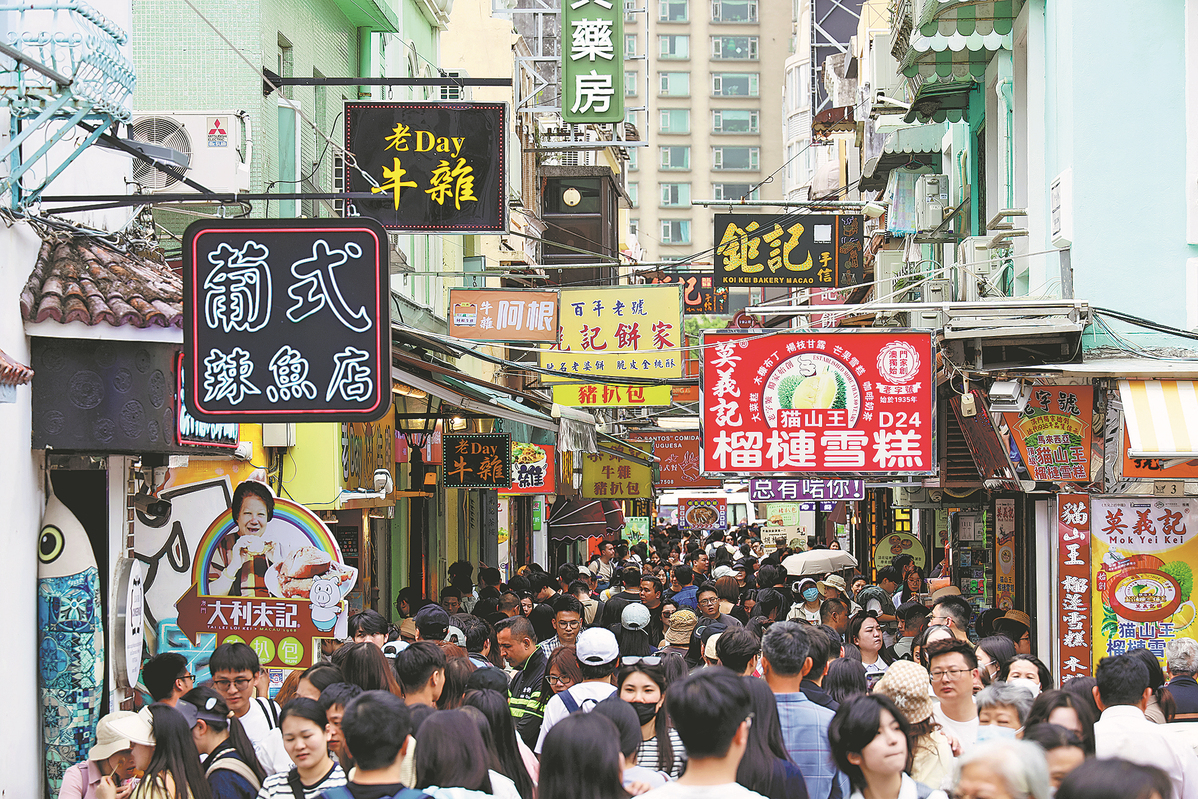
Deeper collaboration among iconic commercial streets in Hong Kong, Macao and Guangdong province's Shenzhen signifies a transition from business rivalry to joint development, a crucial step in developing the Guangdong-Hong Kong-Macao Greater Bay Area into a more appealing global tourism destination, experts said.
Looking ahead, the experts aspire to witness creatively fused activities that authentically blend the unique characteristics of the three cities, more digitalized and intelligent business blocks, and a broader, more coordinated alliance among the cluster's major commercial streets.
The Dongmen Chamber of Commerce in Shenzhen and Macao's Industry and Commerce Federation of Islands signed a cooperation agreement on Aug 8, linking two of the regions' best-known heritage shopping streets — the former's Dongmen Old Street and the latter's Rua do Cunha.
Both streets are key cultural and commercial landmarks. Nestled in Shenzhen's Luohu district, Dongmen, which is among Shenzhen's earliest and largest commercial hubs, has witnessed the city's transformation from a fishing village into a modern metropolis. Meanwhile, Rua do Cunha, formed in the late 19th century, is a pedestrian strip in Macao lined with shops and restaurants that blend Chinese and Portuguese culinary and cultural influences.
The two sides will establish a regular communication mechanism to engage in deep collaboration in areas such as tourism promotion, cultural creativity, brand development, youth entrepreneurship and smart commerce.
This is not the first such initiative. Last July, a similar agreement was struck between Dongmen and Hong Kong's Temple Street, which has since spawned joint food festivals, group tours and sports events, as well as a livestreaming talent program for young people from Hong Kong, Macao and Taiwan.
In September, all three streets will jointly host a mid-autumn food and culture carnival, with synchronized events in Shenzhen, Hong Kong and Macao.
During this year's National Day Golden Week, travel agencies will also roll out a special itinerary linking the three sites, enabling visitors to experience their unique cultures.
According to Shenzhen's Dongmen Chamber of Commerce, such collaborations facilitate the sharing of brand resources and product diversification among commercial streets. The deeper ties also help facilitate the organization of large scale festive events to stimulate consumption and promote tourism through cross-regional travel products.
It attributes the emergence of this new type of collaborative model to the increasing demand for cross-border consumption; the complementary resource advantages among commercial streets; Luohu district's supportive policies for boosting consumption; and the convenient transportation options within the Greater Bay Area.
Iun Ioc-va, chairman of the Industry and Commerce Federation of Islands of Macao, said the effort not only greatly enriches the experience of diverse activities and cultures for travelers all in one single trip, but also boosts consumption in the hotel, dining, retail and other sectors.
He also noted the joint promotion allows for resource integration, creating a stronger market presence that attracts more international visitors, making the Greater Bay Area a more compelling global tourism destination.
Song Ding, director of the research institute of China Urban Experts Network and a researcher of the China Development Institute, pointed out that all three cities have realized that relying solely on individual development is no longer sufficient to support the growth of commercial streets, generating the need to band together for mutual support.
Unlike traditional pure government-led business collaborations, this new model is based on cooperation between commercial districts, with the government providing essential behind-the-scenes support.
Hailing it as a great breakthrough, Song noted that the history of Hong Kong and Macao as free ports and Shenzhen's leadership in free market reforms create a unique foundation for this partnership.
From the chambers' perspectives, they are more attuned to market demands, with greater flexibility in operational decisions, while governments can assist by streamlining administrative procedures such as customs clearance and logistics.
Timothy Chui, executive director of the Hong Kong Tourism Association, described this "pairing" between the three regions as a "two-way pursuit". He noted that the collaboration will not only promote the exchange of goods, people and services, but also allow each region to retain its unique cultural traditions and commercial characteristics.
He added that the upcoming 15th National Games, which will be jointly hosted by Guangdong, Hong Kong and Macao in November, is a key opportunity to further these exchanges.
To improve the effectiveness of the collaboration, Iun said he is looking forward to the launch of brand crossover pop-up stores that bring local specialties to other cities; youth maker markets that showcase innovative products made by young people; and a culinary festival that invites chefs to develop fusion dishes.
He also called for developing a mobile app to integrate merchant information, coupons, event calendars and transportation guides from the three regions, providing tourists with one-stop convenient services.
In the long run, he envisioned forming an alliance to attract more influential commercial streets in the region. Featuring broader coverage and stronger interconnection, he said it will jointly enhance the overall competitiveness of the Greater Bay Area's cultural and tourism industry.
The Dongmen Chamber of Commerce in Shenzhen advocates for enhancing the integration and sharing of distinctive products, cultural heritages and folk activities to bolster business cooperation and tourism route development.
The chamber proposes standardizing logo design and promotional slogans to fortify brand construction and promotion. Additionally, improving customs clearance efficiency and enhancing transportation connections near the border will also help enhance visitors' experiences.
Furthermore, the chamber encourages businesses to participate in cross-border livestreaming events to broaden their sales channels, and looks forward to partnerships among shops for joint operations and brand collaborations.
It emphasized that the key to effectively blending the streets' features is finding the "connecting points" within differences. For instance, the three cities can leverage the cultural commonalities in the region and launch activities centered around Greater Bay Area residents' life memories or folk art expressions.
Echoing the chambers, Song emphasized the need to deeply explore and appropriately present the cultural connotations of different commercial streets. For example, Dongmen Old Street can highlight Shenzhen's citizen culture and reform spirit.
For the commercial streets' long-term development, Song called for upgrading existing facilities, enhancing the blocks' digitalization and intelligence, and making the bustling downtown areas more internationally appealing.
















